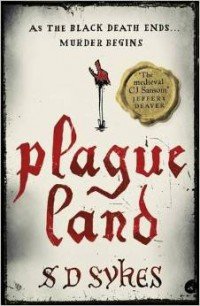The year is 1350 and 17-year-old Oswald de Lacy is the new Lord of Somershill Manor in Kent. The youngest of four siblings he was never meant to inherit, packed off at seven to a monastery to become a monk. But that was before the Black Death which killed his father and two older brothers leaving just his mother, a fearsome matriarch, along with his unmarried and permanently unhappy sister, Clemence. His mother commands that Oswald come home.
Oswald, a naïve young man more used to the routine of the monastery than the politics of command, returns to his birthplace with Brother Peter, the monk who has trained Oswald for the last 10 years and been like a father to him, raising Oswald in the ways of God. Oswald finds the plague has taken its toll. The once great manor and nearby village are in decline, and his people aremistrusting lot and heavily depleted by the plague. Fewer people means fewer servants, and nobody to work in the fields. The crops wilt and die, the house crumbles. What Snowshill needs now is a leader, before the decline becomes terminal. What they get is Oswald.
Before Oswald can take action he is faced with the murder of one of the villagers, Alison Starvecrow. The village priest, Cornwall, a man who is less than godly himself, believes a devil beast, a doghead, has killed her. Oswald has trained in medicine and disagrees. Pressed by Brother Peter he reluctantly begins an investigation. At every turn Oswald finds Cornwall up against him, spreading superstition and heightening the villagers’ fears. Oswald is not strong enough to stand up to the priest and feels he’s steadily losing the limited grip he has on the estate, not helped by his powerful and aggressive neighbour who covets both Snowshill and Clemence.
Before long Oswald believes he has found the killer and the motive. Joan the village whore is locked up.Then a second murder occurs, Alison’s sister goes missing, leaving behind a puddle of blood. The investigation must continue, but what Oswald eventually finds shocks him to his core.
This is a decent historical crime novel, and one element it is not short on is description. The bleak aspect of a community ravaged by pestilence and fear is layered up. It’s grim. And this is a major strength of Plague Land – you will feel transported into the lives and times of Medieval England from top to bottom. The language, culture, behaviours are all there. Most of the time it is a page turner, particularly in the latter half when Oswald spends more time investigating and less worrying about the estate. At other times, the language and the desire of the author to immerse us in the surroundings means the tension wanes. It’s a pity and here and there it is more lecture than literature.
The characters are strong, as are their motivations. All of the de Lacys are enjoyable, Clemence the poisoned sister particularly so. As Oswald gains some backbone he improves too. Pious Peter and self-aggrandising Cornwall are also very strong; even Joan the whore has more to her than initially meets the eye. When the reveal is made it’s a surprise, the web built by SD Sykes is neatly done and all makes good sense. Oswald is due to return in a second installment and, on the strength of Plague Land, will be well worth picking up. If you like immersive, slow burn historical crime then Plague Land will easily fit the bill.
Hodder & Stoughton
Print/Kindle/iBook
£3.80
CFL Rating: 4 Stars









